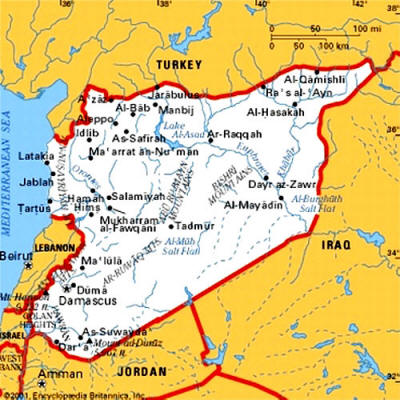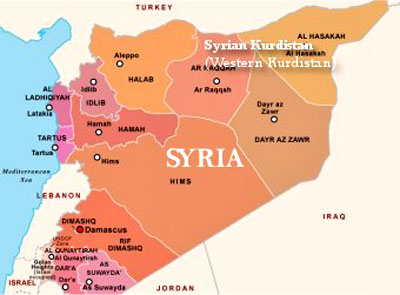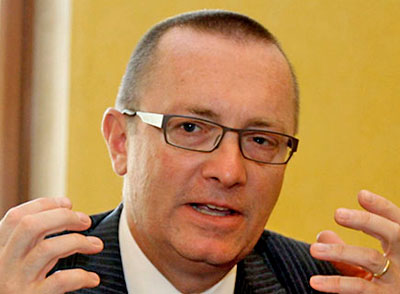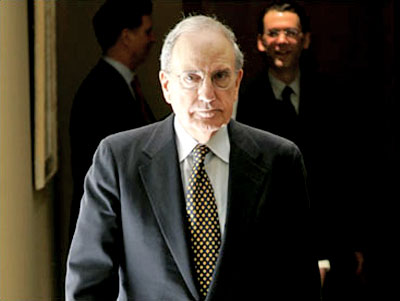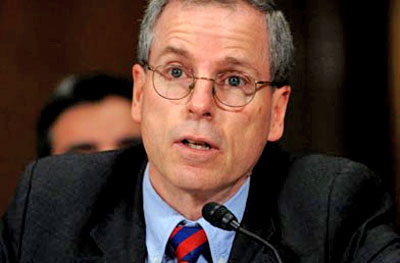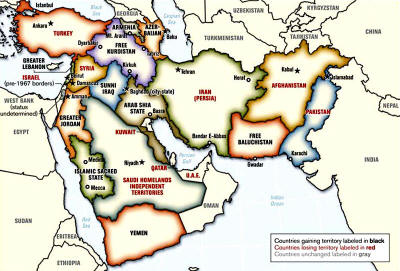|
from GlobalResearch Website
A timely article in the Jerusalem Post in June brings to the forefront the unspoken objective of US foreign policy, namely the breaking up of Syria as a sovereign nation state - along ethnic and religious lines - into several separate and “independent” political entities.
The article also confirms the role of Israel in the process of political destabilization of Syria.
The Jerusalem Post article (May 16, 2012) is titled: “Veteran Kurdish politician calls on Israel to support the break-up of Syria":
The “balkanisation of the Syrian Arab Republic” is to be carried out by fostering sectarian divisions, which will eventually lead to a “civil war” modeled on the former Yugoslavia.
Last month, Syrian “opposition militants” were dispatched to Kosovo to organize training sessions using the “terrorist expertise” of the US sponsored Kosovo Liberation Army (KLA) in fighting the Yugoslav armed forces.
Sherkoh Abbas, President of the US based Kurdistan National Assembly of Syria (KNA) has,
One possible ”break-up scenario” pertaining to Syria, which constitutes a secular multi-ethnic society, would be the formation of separate and “independent” Sunni, Alawite-Shiite, Kurdish and Druze states:
Ironically, while Islamist forces are said to constitute the main threat to the Jewish State, Tel Aviv is providing covert support to the Islamist Free Syrian Army (FSA).
Meeting behind Closed Doors at the US State Department
A top level US State Department meeting was held in May with members of the Syrian Kurdish opposition.
In attendance were representatives of the Kurdish National Council (KNC), Robert Stephen Ford, the outgoing US ambassador to Syria (who has played a key role in channelling support to the rebels) as well as Frederic C. Hof, a former business partner of Richard Armitage, who currently serves as the administration’s “special coordinator on Syria”. (Ibid).
The delegation also met with Assistant Secretary of State for Near Eastern Affairs Jeffrey Feltman.
...are the State Department’s key Syria policy-makers, with close links to the Syrian Free Army (SFA) and the Syrian National Council (SNC).
The public statements of KNA leader Sherkoh Abbas in the wake of the State Department meeting suggest that the political fracturing of the Syrian Arab Republic along ethnic and religious lines as well as the creation of an “independent Kurdistan” were discussed.
The KNA leader called upon Washington to support the creation of a separate Kurdish State consisting of,
It is worth noting, in this regard, that the creation of a “Greater Kurdistan” has been envisaged for several years by the Pentagon as part of a broader “Plan for Redrawing the Middle East”. (See map 2 below)
This option, which appears unlikely in the near future, would go against the interests of Turkey, a staunch ally of both the US and Israel.
Another scenario, which is contemplated by Ankara would consist in the annexation to Turkey of parts of Syrian Kurdistan. (See map above).
Colonel Peters taught at the US Military Academy.
Towards the balkanization (division) and finlandization (pacification) of the Middle East
Map 2
The New Middle East
The following map was prepared by Lieutenant-Colonel Ralph Peters.
It was published in the Armed Forces Journal in June 2006.
This map, as well as other similar maps, has most probably been used at the National War Academy as well as in military planning circles.
|

